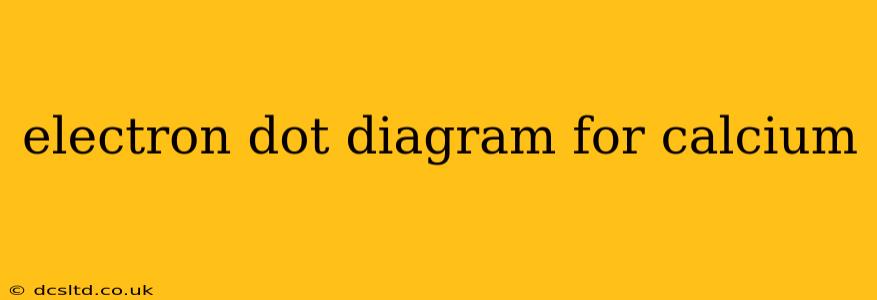Calcium, a vital element for human health and numerous industrial applications, boasts a simple yet significant electron configuration reflected in its electron dot diagram. This diagram provides a visual representation of calcium's valence electrons—the electrons involved in chemical bonding—and is crucial for understanding its reactivity and bonding behavior. This guide will explore the creation and interpretation of calcium's electron dot diagram, answering common questions along the way.
What is an Electron Dot Diagram?
An electron dot diagram, also known as a Lewis dot diagram, is a simplified representation of an atom's valence electrons. It uses the element's symbol and dots to depict these electrons. Each dot represents a single valence electron, placed around the symbol in a specific pattern to illustrate their distribution. Understanding electron dot diagrams is fundamental to predicting how atoms will interact to form chemical bonds.
How to Draw the Electron Dot Diagram for Calcium (Ca)
Calcium's atomic number is 20, meaning it has 20 protons and 20 electrons in a neutral atom. To draw its electron dot diagram, we need to determine its valence electrons. The electron configuration of calcium is 2, 8, 8, 2. The outermost shell (the fourth shell) contains two electrons. Therefore, calcium has two valence electrons.
-
Write the element symbol: Write the symbol for calcium, which is Ca.
-
Place the valence electrons: Place two dots around the Ca symbol, typically one at a time on opposite sides to represent the two valence electrons. It doesn't matter which sides you choose, as long as they're separated.
The final electron dot diagram for calcium looks like this:
. .
Ca
Why are Valence Electrons Important?
Valence electrons are crucial because they are the electrons most likely to participate in chemical reactions. Atoms tend to gain, lose, or share valence electrons to achieve a stable electron configuration, usually a full outermost shell (octet rule). Calcium, with its two valence electrons, readily loses these electrons to form a stable +2 ion (Ca²⁺). This makes it highly reactive with nonmetals, readily forming ionic compounds.
What is the Significance of Calcium's Electron Dot Diagram?
Calcium's electron dot diagram, showing only two valence electrons, immediately reveals its tendency to lose electrons and form ionic bonds. This simple visual representation aids in predicting:
- Calcium's reactivity: The two valence electrons readily participate in chemical reactions, making calcium a relatively reactive metal.
- The type of bonds it forms: Calcium predominantly forms ionic bonds, transferring its two valence electrons to nonmetals to achieve a stable octet.
- The formula of its compounds: Knowing calcium loses two electrons helps predict the formula of ionic compounds it forms (e.g., CaCl₂).
How does Calcium's Electron Dot Diagram Compare to Other Elements?
Comparing calcium's electron dot diagram to other elements highlights the periodic trends in electron configuration and reactivity. For example, magnesium (Mg) in the same group also has two valence electrons, reflecting similar reactivity. However, elements in different groups will have different numbers of valence electrons and thus different chemical behaviors.
What are some common compounds formed by Calcium?
Calcium's ability to readily lose two electrons to form the Ca²⁺ ion leads to the formation of numerous important compounds, including:
- Calcium Oxide (CaO): Used in cement production.
- Calcium Carbonate (CaCO₃): A major component of limestone and marble.
- Calcium Chloride (CaCl₂): Used as a de-icer and in food preservation.
- Calcium Sulfate (CaSO₄): Found in gypsum and plaster.
These are just a few examples demonstrating the importance of calcium's electron configuration and its implications in the formation of crucial compounds.
In conclusion, the electron dot diagram for calcium is a fundamental tool for understanding its chemical behavior. Its simplicity effectively conveys crucial information about its valence electrons, reactivity, and bonding preferences, leading to a better grasp of its significance in various chemical and biological processes.
